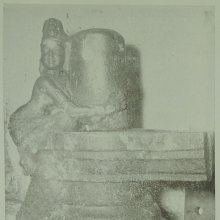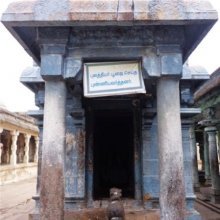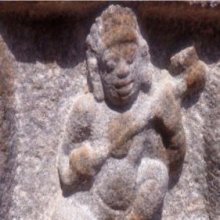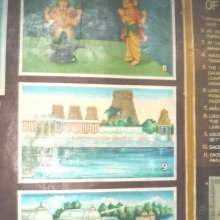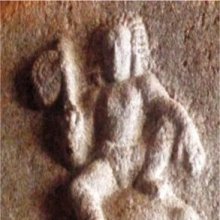Kumbakonam, Kumbhakonam, Kumbakoṇam, Kumbhakoṇam: 2 definitions
Introduction:
Kumbakonam means something in the history of ancient India. If you want to know the exact meaning, history, etymology or English translation of this term then check out the descriptions on this page. Add your comment or reference to a book if you want to contribute to this summary article.
Images (photo gallery)
(+14 more images available)
India history and geography
Source: Wikipedia: India HistoryKumbakonam is a town and a special grade municipality in the Thanjavur district in the southeast Indian state of Tamil Nadu. It is located 40 km (25 mi) from Thanjavur and 273 km (170 mi) from Chennai and is the headquarters of the Kumbakonam taluk of Thanjavur district. The town is bounded by two rivers, the Kaveri River to the north and Arasalar River to the south. Kumbakonam is also known as Baskarashetram and Kumbam from time immemorial and as Kudanthai in ancient times.
Etymology: The name “Kumbakonam”, roughly translated in English as the “Pot’s Corner”, is believed to be an allusion to the mythical pot (kumbha) of the Hindu god Brahma that contained the seed of all living beings on earth. The kumbha is believed to have been displaced by a pralaya (dissolution of the universe) and ultimately came to rest at the spot where the town of Kumbakonam now stands. This event is now commemorated in the Mahamaham festival held every 12 years.
History: The region around Kumbakonam was inhabited as early as the Sangam Age (3rd century BC to 3rd century AD). The present-day Kumbakonam is believed to be the site of the ancient town of Kudavayil where the Early Chola king Karikala held his court. Kumbakonam is identified with the town of Malaikurram which had served as the Chola capital as early as the 7th century and with the town of Solamaligai which had also served as a Chola capital.
Temples: Kumbakonam is known for its temples and mathas (monasteries). There are around 188 Hindu temples within the municipal limits of Kumbakonam. Apart from these, there several thousand temples around the town thereby giving the town the sobriquets “Temple Town” and “City of temples”.
Shaivism: Adi Kumbeswarar Temple is considered to be the oldest Shaiva (the sect of the god Shiva) shrine in the town, believed to be constructed by the Cholas in the 7th century. The Nageswaraswamy Temple has a separate shrine for the Sun god Surya who is believed to have worshipped Shiva at this place.
Vaishnavism: Sarangapani temple is the largest Vaishnava (the sect of the god Vishnu) shrine present in Kumbakonam. The present structure of the temple having a twelve storey high tower was constructed by Nayak kings in the 15th century. It is one of the "Divya Desams", the 108 temples of Vishnu revered by the 12 Alvar saint-poets.
Source: Shodhganga: The significance of the mūla-beras (history)Kumbakonam (Kumbhakonam) is the place where Adi Kumbeswarar Temple (Ādi Kumbheśvara) is located, representing a sacred place for the worship of Śiva.—Kumbhakonam (Kumbakonam), flanked by the rivers Kaveri and the Arisilar, is a beautiful city situated in Tanjore District. The city is noted for its antiquity. It was once the capital of the Cholas. The city flourished even before the 7th and the 8th centuries AD. This temple is situated west of the Sāraṅgapani Temple and it faces east.
Source: Shodhganga: Siddha Cult in TamilnaduKumbakonam refers to one of the various famous Siddha Centre distributed throughout South India and Tamil Nadu. The Siddha cult represents a Tantric philosophy that emerged from the combination of several elements found in traditions such as Shaivism (viz., Pashupata), Shaktism, Jainism, Tantric Buddhism (Vajrayana), etc. Both the Siddha and the Navanath cult (i.e., Nava-natha, ‘nine saints’) are popular in South India [viz., Kumbakonam] and Tamilnadu. A Siddha was an inspired seer belonging to the marginalized sections of society who dissolved their past karma and crushed the roots of future karma.

The history of India traces the identification of countries, villages, towns and other regions of India, as well as mythology, zoology, royal dynasties, rulers, tribes, local festivities and traditions and regional languages. Ancient India enjoyed religious freedom and encourages the path of Dharma, a concept common to Buddhism, Hinduism, and Jainism.
See also (Relevant definitions)
Starts with: Kumpakonam.
Ends with: Kumpakonam.
Full-text (+49): Dharmasastha, Munti, Dantin, Karttikeya, Ramaswamy, Ramasvamin, Kiratamurti, Uma, Gouri, Ambikai, Kanambikai, Mangalambikai, Jurakareshvara, Bharata, Svamishaulamahatmya, Tirukkutantai, Kumpakonam, Shirkali, Lakshmana, Kutantai.
Relevant text
Search found 29 books and stories containing Kumbakonam, Kumbhakonam, Kumbakoṇam, Kumbhakoṇam; (plurals include: Kumbakonams, Kumbhakonams, Kumbakoṇams, Kumbhakoṇams). You can also click to the full overview containing English textual excerpts. Below are direct links for the most relevant articles:
Preceptors of Advaita (by T. M. P. Mahadevan)
The Kumbakonam Fire < [October – December, 2004]
Sculpture at its Best < [May-June, 1929]
Srinivasa Ramanujam < [October – December, 1996]
Later Chola Temples (by S. R. Balasubrahmanyam)
Temples in Korukkai (Rajanarayanapuram) < [Chapter XII - Temples of Kulottunga III’s Time]
Appendix 1: Mote on M. Sethuraman’s views on Rajadkiraja II < [Chapter IX - Rajadhiraja II (a.d. 1166 to 1182)]
Temples in Pattisvaram (Palayarai-Malapadi) < [Chapter X - Temples of Rajadhjraja II’s Time]
Lalitopakhyana (Lalita Mahatmya) (by G.V. Tagare)
Early Chola Temples (by S. R. Balasubrahmanyam)
Aditya I < [Chapter XIV - Conclusion]
Temples in Tirukkalavur (Tirukkarugavur) < [Chapter II - Temples of Parantaka I’s Time]
Panels of Miniature-Sculptures < [Chapter XIII - Prasada: Component Parts]
Middle Chola Temples (by S. R. Balasubrahmanyam)
Temples In Alagadriputtur < [Chapter II - Temples of Rajaraja I’s Time]
Temples In Tiruvalanjuli < [Chapter II - Temples of Rajaraja I’s Time]
The Central Shrine < [Tanjavur/Thanjavur (Rajarajesvaram temple)]
Related products
